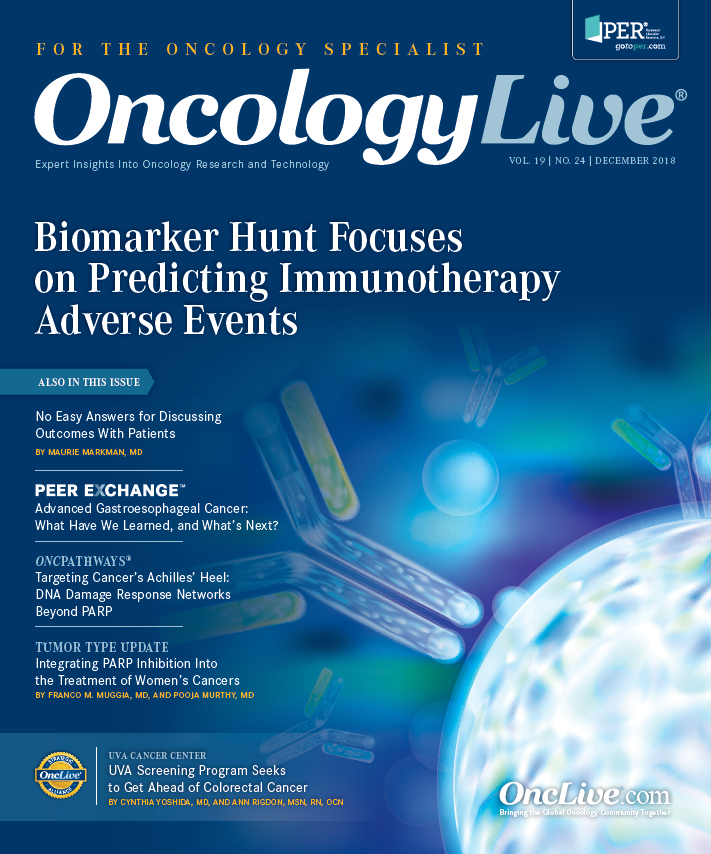Publication
Article
Oncology Live®
Developing Alternative Payment Models That Providers and Commercial Payers Support
Author(s):
Although some of the improvement is a result of prevention and screening, advances in technology and in chemotherapy and immunotherapy pharmaceuticals have been major driving forces in the decline in cancer-related death.

David C. Fryefield, MD
Patients with cancer in the United States have significantly benefited from steady improvement in treatment outcomes over the past few decades. Data from the National Cancer Institute show a large decline in the cancer death rate, down by 25% since 1990.1 Although some of the improvement is a result of prevention and screening, advances in technology and in chemotherapy and immunotherapy pharmaceuticals have been major driving forces. These advances have come at a significant cost, however. A 2011 study projected that the cost of all cancer care in the United States would rise to $157.7 billion by 2020, up from $124.5 billion in 2010.2
In an attempt to control the cost of care, many commercial payers have implemented prior authorization (PA) requirements. For oncologists, the result has been a huge administrative burden, with increasing denial rates and a drop in overall payment for services.3 A survey of American Society of Clinical Oncology stateaffiliate organizations found that the PA process increased demands on staff time, delayed patient care, decreased patient satisfaction, and complicated medical decision making.4 In addition, the actual cost-reduction benefit of applying strict PA requirements to the fee-for-service system has been questioned.5
Enter the Oncology Care Model and APMs for Covering Radiation Therapy
Robert Mechanic, MBA, and Robert Galvin, MD, wrote in the New England Journal of Medicine that “we cannot solve this spending crisis without substantial changes in the way care is delivered. But widespread delivery-system restructuring will not occur as long as fee-for-service is the dominant method of healthcare payment.” They also noted that adoption of alternative payment models (APMs) by commercial health plans has been slow.6 My organization, The US Oncology Network (The Network), has embraced the concept of APMs for oncology services, and we have participated in many discussions with commercial payers. Despite our efforts, we’ve experienced slow adoption of APMs by commercial payers, similar to the experience described by Mechanic and Galvin.Medicare has been actively transitioning provider payments into APMs since 2010.7 In 2016, the Center for Medicare and Medicaid Innovation launched the Oncology Care Model (OCM), a 5-year model to test innovative payment strategies that promote both high-quality and high-value cancer care. Fifteen practices within The Network are participating in the OCM.
Based on the OCM experience, The Network has also been eager to develop new value-based payment models for commercial payers that more accurately align incentives with the care provided. Because the OCM does not directly address radiation oncology services, The Network created its own radiation oncology APM models that address commercial payment.
The Network’s radiation APM offerings fall into 2 categories: Episode of Care bundled payments and Capitation Payment. The Network developed different APM options because, based on our experience, various payers may prefer one model over another. However, each of the models is driven by the desire to move away from traditional payment to more predictable episode-based bundles.
The Episode of Care model was designed to be flexible, as either a disease site/stage—based model or a modality-based platform. The framework provides prepayment for a defined single episode of care based on the disease site or stage. The modality-based model provides prospective payment for an episode of care using case rates based on various radiation technologies, including 3D conformal therapy, intensity-modulated radiation therapy, stereotactic radiosurgery/stereotactic body radiotherapy, and highdose- rate/low-dose-rate brachytherapy.
In the Capitation Payment model, providers take on more cost risk for patient care and are paid on a per-member, per-month basis for all services rendered to patients within a health plan. Currently, the Capitation Payment model is less common than the Episode of Care case rate model among the number of practices in The Network that are already using radiation APMs.
Both models support quality care with improved outcomes and patient experience at a sustainable cost. They allow the physician to practice medicine while encouraging treatment optimization by adhering to preauthorized treatment guidelines and algorithms.
The Missing Elements Needed for APM Success
Given the unsustainable increase in the cost of oncology care delivery, the widespread dissatisfaction with incentives inherent in the fee-for-service payment system, and the wil lingness of a large provider group of more than 1400 oncologists such as The Network to embrace bundled or capitated payment models, why has commercial-payer adoption of APMs been slow?In our experience, payers have not been able to rapidly incorporate APMs. We have found that APM discussions with commercial payers are often met with initial high-level enthusiasm but soon get bogged down in the details. Typically, a number of barriers appear. The first is trust. Agreeing to make the change to an alternative method of payment for oncology services requires a trusting relationship, a partnership between provider groups and commercial payers. Data sharing is necessary to achieve bundled rates that do not put either party at a disadvantage. Providers and commercial payers have a history of protecting their financial and usage data. But without transparency, provider groups and payers will find it difficult to reach agreement on a contract that meets the objectives of financial stability and predictability for each while maintaining support for quality patient care.
Bundled or capitated payment models are attractive to commercial payers because providers accept a greater degree of financial risk. In exchange for the assumption of greater risk, however, providers expect to be rewarded. Rewards can be structured as shared savings payments, elimination of the administrative burden of PA, or an increase in referral rates of health plan patients. We have found commercial payers to be less willing or less able to agree to add value to contracts through these means. In fact, some commercial payers have shown interest in adding collection and reporting of various quality metrics. Additional data reporting paradoxically increases rather than decreases the administrative burden of the contract and adds to the complexity of the APM.
Another issue is the potential for highperforming, efficient practices to be put at a disadvantage in a bundled payment model. Bundled case rates calculated from baseline fee-for-service payment history will be lower for a practice that has already incorporated more efficient care through standardization of clinical practice and guideline implementation. It should be in a commercial payer’s interest to attract and support high-performing, efficient providers, which would provide incentive for greater adoption of APMs.
Finally, alternative payment systems are usually not supported within most commercial payers’ traditional information technology infrastructure, which is specifically designed around fee-for-service. Receiving and processing payments, as well as data analysis, often requires payers to develop a separate workflow, and this sometimes becomes a manual process.
What is the Future of Oncology APMs for Commercial Payers?
Despite these and other barriers, a limited number of practices within The Network have been able to reach agreement on a radiation APM with a commercial payer. The feedback from the practices and the payers has been generally positive. In one notable example, there have been documented cost savings by the health plan and a significant reduction in coinsurance payments by patients within the plan who have received radiation treatments. The practice has benefited through an increase in patient volume.The disadvantages and misaligned incentives of the fee-for-service payment system are well known and continue to be a source of frustration and dissatisfaction for payers, providers, and patients. Yet there are significant barriers to change, and adoption of alternative models has been slow. Will oncology providers need to practice in a dual system—one in which Medicare rewards high-quality and highvalue care while commercial payers persevere with fee for service, albeit restricted through PAs, denials, and payment reductions? At The Network, we continue to engage with commercial payers to encourage evolution toward a payment system that supports and rewards high-quality, high-value care for all our patients.
References
- Leading the nation’s progress against cancer. cancer.gov/ about-nci/budget/plan/progress. Accessed November 15, 2018.
- Mariotto AB, Yabroff KR, Shao, Y, Feuer EJ, Brown ML. Projections of the cost of cancer care in the United States: 2010—2020. J Natl Cancer Inst. 2011;103(2):117-128. doi: 10.1093/jnci/djq495.
- Agarwal A, Freedman RA, Goicuria F, et al. Prior authorization for medications in a breast oncology practice: navigation of a complex process. J Oncol Pract. 2017;13(4):e273-e282. doi: 10.1200/JOP.2016.017756.
- American Society of Clinical Oncology. The state of cancer care in America, 2015: a report by the American Society of Clinical Oncology. J Oncol Pract. 2015;11(2):79-113. doi: 10.1200/ JOP.2015.003772.
- Bergeson JG, Worley K, Louder A, Ward M, Graham J. Retrospective Database Analysis of the Impact of Prior Authorization for Type 2 Diabetes Medications on Health Care Costs in a Medicare Advantage Prescription Drug Plan Population. J Manag Care Pharm. 2013;19(5):374-384. doi: 10.18553/ jmcp.2013.19.5.374.
- Mechanic RE, Galvin RS. Self-insured employers — the payment- reform wild card. N Engl J Med. 2018; 379(4):308-310. doi: 10.1056/NEJMp1801544.
- Obama B. United States health care reform: progress to date and next steps. JAMA. 2016;316(5):525-532. doi: 10.1001/ jama.2016.9797.










